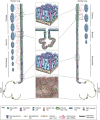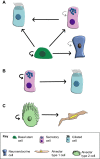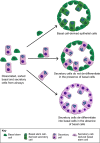Plasticity in the lung: making and breaking cell identity
- PMID: 28246210
- PMCID: PMC5374348
- DOI: 10.1242/dev.143784
Plasticity in the lung: making and breaking cell identity
Abstract
In contrast to a prior emphasis on the finality of cell fate decisions in developmental systems, cellular plasticity is now emerging as a general theme in the biology of multiple adult organ systems. In the lung, lineage tracing has been used to identify distinct epithelial stem and progenitor cell populations. These cells, together with their differentiated progeny, maintain a stable identity during steady state conditions, but can display remarkable lineage plasticity following injury. This Review summarizes our current understanding of the different cell lineages of the adult mammalian lung and their responses to injury. In the lung, which is constantly exposed to infection and aerosolized toxins, epithelial plasticity might be more of a rule than an exception, and it is likely that different injuries elicit different facultative responses.
Keywords: Cellular heterogeneity; Cellular plasticity; Lineage tracing; Lung injury repair; Lung regeneration; Lung stem cells.
© 2017. Published by The Company of Biologists Ltd.
Conflict of interest statement
The authors declare no competing or financial interests.
Figures





Similar articles
-
Epithelial progenitor cells in lung development, maintenance, repair, and disease.Annu Rev Cell Dev Biol. 2011;27:493-512. doi: 10.1146/annurev-cellbio-100109-104040. Epub 2011 May 31. Annu Rev Cell Dev Biol. 2011. PMID: 21639799 Review.
-
Epithelial Stem and Progenitor Cells in Lung Repair and Regeneration.Annu Rev Physiol. 2021 Feb 10;83:529-550. doi: 10.1146/annurev-physiol-041520-092904. Epub 2020 Oct 19. Annu Rev Physiol. 2021. PMID: 33074772 Free PMC article. Review.
-
Types or States? Cellular Dynamics and Regenerative Potential.Trends Cell Biol. 2015 Nov;25(11):687-696. doi: 10.1016/j.tcb.2015.07.008. Epub 2015 Oct 1. Trends Cell Biol. 2015. PMID: 26437587 Free PMC article. Review.
-
Stem Cells in Pulmonary Disease and Regeneration.Chest. 2018 Apr;153(4):994-1003. doi: 10.1016/j.chest.2017.07.021. Epub 2017 Aug 2. Chest. 2018. PMID: 28780147 Review.
-
Stem cell plasticity. Plasticity of epithelial stem cells in tissue regeneration.Science. 2014 Jun 13;344(6189):1242281. doi: 10.1126/science.1242281. Epub 2014 Jun 12. Science. 2014. PMID: 24926024 Free PMC article. Review.
Cited by
-
WNT Signaling in Lung Repair and Regeneration.Mol Cells. 2020 Sep 30;43(9):774-783. doi: 10.14348/molcells.2020.0059. Mol Cells. 2020. PMID: 32807748 Free PMC article. Review.
-
The many fates of tissue regeneration.PLoS Genet. 2018 Nov 21;14(11):e1007728. doi: 10.1371/journal.pgen.1007728. eCollection 2018 Nov. PLoS Genet. 2018. PMID: 30462634 Free PMC article. No abstract available.
-
New Translational Trends in Personalized Medicine: Autologous Peripheral Blood Stem Cells and Plasma for COVID-19 Patient.J Pers Med. 2022 Jan 10;12(1):85. doi: 10.3390/jpm12010085. J Pers Med. 2022. PMID: 35055400 Free PMC article.
-
Differences in the anatomy and physiology of the human and rat respiratory tracts and impact on toxicological assessments.Regul Toxicol Pharmacol. 2024 Jun;150:105648. doi: 10.1016/j.yrtph.2024.105648. Epub 2024 May 20. Regul Toxicol Pharmacol. 2024. PMID: 38772524 Review.
-
Non-lytic clearance of influenza B virus from infected cells preserves epithelial barrier function.Nat Commun. 2019 Feb 15;10(1):779. doi: 10.1038/s41467-019-08617-z. Nat Commun. 2019. PMID: 30770807 Free PMC article.
References
-
- Beura L. K., Hamilton S. E., Bi K., Schenkel J. M., Odumade O. A., Casey K. A., Thompson E. A., Fraser K. A., Rosato P. C., Filali-Mouhim A. et al. (2016). Normalizing the environment recapitulates adult human immune traits in laboratory mice. Nature 532, 512-516. 10.1038/nature17655 - DOI - PMC - PubMed
Publication types
MeSH terms
Grants and funding
LinkOut - more resources
Full Text Sources
Other Literature Sources
Medical

